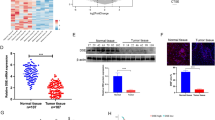Abstract
Decorin, a member of the family of small leucin-rich proteoglycans, has originally been described as a secreted proteoglycan component of the connective tissues, and has been implicated in the negative regulation of cell proliferation directly or via interactions with TGF-β. It was reported to be generally absent from tumor cells. Here we show that human melanoma cell lines express a decorin-like molecule. We detected decorin mRNA by RT-PCR in 7 out 7 human melanoma lines characterized by various metastatic potential. Using polyclonal antiserum against the core protein of decorin, the typical 80–120 kD glycanated form as well as a high molecular weight aberrant version (200–210 kD) of decorin were demonstrated by Western blot technique in the culture supernatants as well as in lysates of human melanoma cells. Finally, decorin epitope was also demonstrated immunohistochemically in human melanoma xenografts, as well as in tumor cells of surgically resected melanomas but not in melanocytes of nevi. The expression of this aberrant decorin did not inhibit thein vitro orin vivo growth of human melanoma cells, and it was independent of their metastatic potential. Human melanoma cell lines expressing aberrant decorin retained sensitivity to the antiproliferative and gelatinase-stimulatory effects of exogenous TGF-β.
Similar content being viewed by others
Abbreviations
- CS:
-
chondroitin sulfate
- PG:
-
proteoglycan
- TGF:
-
transforming growth factor
References
Krusius T, Ruoslahti E: Primary structure of an extracellular matrix proteoglycan core protein deduced from cloned cDNA. Proc Natl Acad Sci USA 83:7683–7687, 1986.
Iozzo RV: The family of the small leucine-rich proteoglycans: key regulators of matrix assembly and cellular growth. Crit Rev Biochem Mol Biol 32:141–174, 1997.
Yamaguchi Y, Mann DM, Ruoslahti E: Negative regulation of transforming growth factor-β by the proteoglycan decorin. Nature 346:281–284, 1990.
Border WA, Noble NA, Yamamoto T, et al: Natural inhibitor of transforming growth factor-β protects against scarring in experimental kidney disease. Nature 360361-364, 1992.
Takeuchi Y, Kodama Y, Matsumoto T: Bone matrix decorin binds transforming growth factor-β and enhances its bioactivity. J Biol Chem 269:32634–32638, 1994.
Hausser H, Gröning A, Hasilik A, et al.: Selective inactivity of TGF-β/decorin complexes. FEBS Lett 353:243–245, 1994.
Coppock DL, Kopman C, Scandalis S, et al: Preferential gene expression in quiescent human lung fibroblasts. Cell Growth Differ 4:483–493, 1993.
Mauviel A, Santra M, Chen YQ, et al: Transcriptional regulation of decorin gene expression. Induction by quiescence and repression by tumor necrosis factor-α. J Biol Chem 270:11692–11700, 1995.
Santra M, Mann DM, Mercer EW, et al: Ectopic expression of decorin protein core causes a generalized growth suppression in neoplastic cells of various histogenetic origin and requires endogenous p21, an inhibitor of cyclin-dependent kinases. J Clin Invest 100:149–157, 1997.
Yamaguchi Y, Ruoslahti E: Expression of human proteoglycan in Chinese hamster ovary cells inhibits cell proliferation. Nature 336:244–246, 1988.
De Luca A, Santra M, Baldi A, et al: Decorin-induced growth suppression is associated with up-regulation of p21, an inhibitor of cyclin-dependent kinases. J Biol Chem 271:18961–18965, 1996.
Adany R, Heimer R, Caterson B, et al.: Altered expression of chondroitin sulfate proteoglycan in the stroma of human colon carcinoma. Hypomethylation of PG-40 gene correlates with increased PG-40 content and mRNA levels. J Biol Chem 265:11389–11396, 1990.
Pluschke G, Vanek M, Evans A, et al: Molecular cloning of a human melanoma-associated chondroitin sulfate proteoglycan. Proc Natl Acad Sci USA 93:9710–9715, 1996.
Iida J, Meijne AML, Knutson JR, et al: Cell surface chondroitin sulfate proteoglycans in tumor cell adhesion, motility and invasion. Semin Cancer Biol 7:155–162, 1996.
Timár J, Ladányi A, Lapis K, et al: Differential expression of proteoglycans on the surface of human melanoma cells characterized by altered experimental metastatic potential. Am J Pathol 141:467–474, 1992.
Caux F, Timar J, Lapis K, Moczar M: Proteochondroitin sulphate in human melanoma cell cultures. Biochem Soc Transact 18:293–294, 1990.
Tímár J, Jeney A, Kovalszky I, Kopper L: Role of proteoglycans in tumor progression. Pathol Oncol Res 1:85–93, 1995.
Ladányi A, Tímár J, Paku S, et al: Selection and characterization of human melanoma lines with different liver-colonizing capacity. Int J Cancer 46:456–461, 1990.
Ladányi A, Tímár J, Bocsi J, et al: Sex-dependent liver metastasis of human melanoma lines in SCID mice. Melanoma Res 5:83–86, 1995.
Ladányi A, O. Nagy J, Jeney A, et al: Cytokine sensitivity of metastatic human melanoma cell lines - simultaneous inhibition of proliferation and enhancement of gelatinase activity. Pathol Oncol Res 4:108–114, 1998.
Vogel KG, Ördög A, Pogány G, et al: Proteoglycans in the compressed region of human tibialis posterior tendon and in ligaments. J Orthop Res 11:68–77, 1984.
Mueller BM, Romerdahl CA, Trent JM, et al: Suppression of spontaneous melanoma metastasis in scid mice with an antibody to the epidermal growth factor receptor. Cancer Res 51:2193–2198, 1991.
Bani MR, Rak J, Adachi D, et al: Multiple features of advanced melanoma recapitulated in tumorigenic variants of early stage (radial growth phase) human melanoma cell lines: evidence for a dominant phenotype. Cancer Res 56:3075–3086, 1996.
Tímár J, Kovalszky I, Paku S, et al.: Two human melanoma xenografts with different metastatic capacity and glycosaminoglycan pattern. J Cancer Res Clin Oncol 115:554–557, 1989.
Voss B, Glössl J, Cully Z, Kresse H: Immunocytochemical investigation on the distribution of small chondroitin sulfatedermatan sulfate proteoglycan in the human. J Histochem Cytochem 34:1013–1019, 1986.
Imai K, Hiramatsu A, Fukushima D, et al: Degradation of decorin by matrix metalloproteinases: identification of the cleavage sites, kinetic analyses and transforming growth factor-1 release. Biochem J 322:809–814, 1997.
Danielson KG, Fazzio A, Cohen I, et al: The human decorin gene: intron-exon organization, discovery of two alternatively spliced exons in the 5′ untranslated region, and mapping of the gene to chromosome 12q23. Genomics 15:146–160, 1993.
Author information
Authors and Affiliations
Corresponding author
Rights and permissions
About this article
Cite this article
Ladányi, A., Gallai, M., Paku, S. et al. Expression of a decorin-like molecule in human melanoma. Pathol. Oncol. Res. 7, 260–266 (2001). https://doi.org/10.1007/BF03032382
Received:
Accepted:
Issue Date:
DOI: https://doi.org/10.1007/BF03032382




